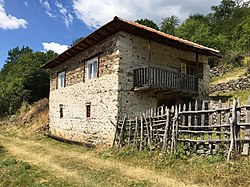Krakornica
Krakornica
Кракорница Krakarnicë | |
|---|---|
Village | |
 Traditional old house in the village | |
| Coordinates: 41°45′N 20°42′E / 41.750°N 20.700°E | |
| Country | |
| Region | |
| Municipality | |
| Population (2002) | |
| • Total | 15 |
| Time zone | UTC+1 (CET) |
| • Summer (DST) | UTC+2 (CEST) |
| Car plates | GV |
| Website | . |
Krakornica (Macedonian: Кракорница, Albanian: Krakarnicë) is a village in the municipality of Mavrovo and Rostuša, North Macedonia.
Geography[edit]
Krakornica is located between the Korab and Šar Mountains. It is located 31km from the town of Gostivar. At an altitude of 1530 m, it is considered the highest inhabited settlement in North Macedonia.[1]
History[edit]
Krakornica (Kurakornica) is recorded in the Ottoman defter of 1467 as a village in the ziamet of Reka. The settlement had a total of three households represented by household heads all bearing Albanian anthroponymy.[2]
According to Ethnographie des Vilayets D'Andrinople, de Monastir, et de Salonique, published in Constantinople in 1878, the village had a total of 80, households with 83 Muslim Albanian and 120 Orthodox Albanian inhabitants.[3] In statistics gathered by Vasil Kanchov in 1900, the village of Krakornica was inhabited by 180 Orthodox Albanians and 180 Muslim Albanians.[4] In 1905 in statistics gathered by Dimitar Mishev Brancoff, Krakornica was inhabited by 210 Albanians and had a Bulgarian school.[5] Christian Albanians were attracted by Serbian propaganda and according to the statistics of the newspaper " Debarski Glas " in 1911 there were 64 Albanian Patriarchist houses in Krakornica.[6]
Due to the Balkan Wars, Muslim residents of Krakornica abandoned the village.[7]
According to a 1929 ethnographic map by Russian Slavist Afanasy Selishchev, Krakornica was an Albanian village.[8]
Demographics[edit]
Krakornica's population in Yugoslav and Macedonian censuses has been ethnic Macedonian.[9] According to the 2021 census, Krakornica had 1 resident.[10]
| Ethnic group |
census 1953 | census 1961 | census 1971 | census 1981 | census 1991 | census 1994 | census 2002 | census 2021 | ||||||||
|---|---|---|---|---|---|---|---|---|---|---|---|---|---|---|---|---|
| Number | % | Number | % | Number | % | Number | % | Number | % | Number | % | Number | % | Number | % | |
| Macedonians | 142 | 99.3 | 166 | 99.4 | 112 | 100.0 | 73 | 97.3 | 23 | 100.0 | 30 | 100.0 | 15 | 100.0 | 1 | 100.0 |
| Serbs | 1 | 0.7 | 0 | 0.0 | 0 | 0.0 | 0 | 0.0 | 0 | 0.0 | 0 | 0.0 | 0 | 0.0 | 0 | 0.0 |
| Albanians | 0 | 0.0 | 1 | 0.6 | 0 | 0.0 | 0 | 0.0 | 0 | 0.0 | 0 | 0.0 | 0 | 0.0 | 0 | 0.0 |
| others | 0 | 0.0 | 0 | 0.0 | 0 | 0.0 | 2 | 2.7 | 0 | 0.0 | 0 | 0.0 | 0 | 0.0 | 0 | 0.0 |
| Total | 143 | 167 | 112 | 75 | 23 | 30 | 15 | 1 | ||||||||
Culture[edit]
In 2007 author Edibe Selimi-Osmani recorded a number of folk songs of the Upper Reka region. Among these the song Trandafil në ferrë (rose amongst the thorns) is recorded from the Krakornica native and Albanian speaker Grozda Nikolovska.[11]
References[edit]
- ^ Панов, Митко (1998). Енциклопедија на селата во Република Македонија: географски, демографски, и аграрни обележја (in Macedonian). p. 162.
- ^ Caka, Eduart (2019). Defteri i hollësishëm për zonat e dibrës i vitit 1467. Tiranë: Akademia e studimeve albanologjike instituti historisë. p. 128. Gjon Vuçe, Gjon Gjirgjiti (possibly, Gjergjeti), and Miho Mekshe
- ^ "Section: Ethnographie du Vilayet de Monastir (Bitolia), p. 55.". Ethnographic des Vilayets d'Andrinople, de Monastir, et de Salonique. Constantinople. 1878.
{{cite book}}: CS1 maint: location missing publisher (link) - ^ Vasil Kanchov (1900). Macedonia: Ethnography and Statistics. Sofia. p. 264.
- ^ D.M.Brancoff (1905). La Macédoine et sa Population Chrétienne. Paris. pp. 184-185.
- ^ Дебърски глас, година 2, брой 38, 3 април 1911, стр. 2.
- ^ Sherafedin Kaso (2005). The settlements with Muslim population in Macedonia. Logos-A. p. 163. ISBN 978-9989-58-155-7.
- ^ Афанасий Селищев. „Полог и его болгарское население. Исторические, этнографические и диалектологические очерки северо-западной Македонии“. – София, 1929, стр. 26.
- ^ Censuses of population 1948 - 2002
- ^ Total resident population of the Republic of North Macedonia by ethnic affiliation, by settlement, Census 2021
- ^ Murati, Qemal (2011). "Gjuha e humbur: Vëzhgime historike, linguistike, onomastike dhe folklorike rreth shqiptarëve ortodoksë në etnoregjionin e Rekës së Epërme të Mavrovës [Lost Language: Historical, Linguistic, Onomastic and Folkloric observations about the Orthodox Albanians in ethno-region of Upper Reka in Mavrovo]". Studime Albanologjike. 3: 109. Trandafil në ferrë Trandafil në ferrë Çe na erdh lumja verë, ooo ih! Vera erdh e shkaj, Mulleza nuk pushoj. Vera jerdh e shkaj Shyshja nuk kindoj, ooo ih! Vera jerdh e shkaj Shyshja nuk pushoj. Trandalin në kaçë Tre jarana paç! Besën sun u dhashë ooo ih! Këndoi: Grozda Nikollovska, e lindur më 1932 në fshatin Krakornicë, Reka e Epërme. Shënoi: Edibe Selimi – Osmani (Osmani 2007)....Subjektet që i kanë kënduar këto këngë, si Igne Qiprovski, Ilinka Jankulloska, Grozda Nikollovska, Naza Nikolloska, Svetllana Jankullovska, Bllagorodna Ilioska, nga të Rekës së Epërme, janë shqiptarë të besimit ortodoks, që ruajtën gjuhën e tyre amtare shqipe, por konvertuan emrat e tyre personalë në ata të burimit sllav.

